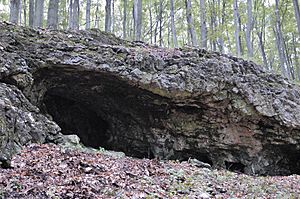Rock shelter facts for kids
A rock shelter is like a shallow cave or a natural overhang found at the bottom of a cliff. Imagine a big rock wall, and at its base, there's a protected, open space. That's a rock shelter! These natural shelters have been important places for animals and humans for thousands of years, offering protection from weather and predators.

Contents
How Rock Shelters Form
Rock shelters are created by a process called erosion, which is when natural forces like wind and water wear away at rocks.
The Role of Different Rock Layers
Rock shelters form because of different types of rock layers in a cliff. Think of a cliff as a giant sandwich made of different kinds of rock.
- Harder Rock Layer: At the top, there's usually a strong, tough layer of rock that doesn't wear away easily. This hard rock forms the top part of the cliff and acts like a roof.
- Softer Rock Layer: Below this hard layer, there's a weaker, softer layer of rock. This softer rock is much easier for wind, rain, and even ice to break down and carry away.
The Erosion Process
Over a very long time, the softer rock layer at the bottom of the cliff erodes much faster than the hard rock above it. As the softer rock slowly disappears, it creates an opening or a hollow space underneath the harder rock layer. This hollow space is what we call a rock shelter. It's like the harder rock is sticking out, creating a natural roof over the eroded space below.
Why Rock Shelters Are Important
Rock shelters might seem simple, but they have played a huge role in history and are very important for scientists today.
Homes for Early Humans
For thousands of years, rock shelters were perfect homes for early humans, including our ancestors from the Paleolithic (Stone Age) period.
- Protection: They offered natural protection from harsh weather like rain, snow, and strong winds. They also provided safety from wild animals.
- Shelter and Comfort: The dry, sheltered space inside was a good place to build fires, cook food, and sleep.
- Easy to Find: Unlike deep caves, rock shelters are open and easy to access, making them convenient places to live for people who were always on the move.
Clues from the Past
Archaeologists, who are scientists who study human history, love to explore rock shelters.
- Ancient Artifacts: Because people lived in these shelters for so long, they often left behind tools, weapons, pottery, and even ancient artwork on the walls.
- Understanding Life: By carefully digging and studying these items, archaeologists can learn a lot about how early humans lived, what they ate, what tools they used, and even their beliefs and art. Rock shelters are like natural time capsules, preserving clues about our past.
Images for kids
-
The rock shelter for which Indian Cave State Park is named.
-
Shepherds' rock shelter in Lahaul, India
-
Rock shelter at Strouds Run State Park
See also
 In Spanish: Abrigo rocoso para niños
In Spanish: Abrigo rocoso para niños





